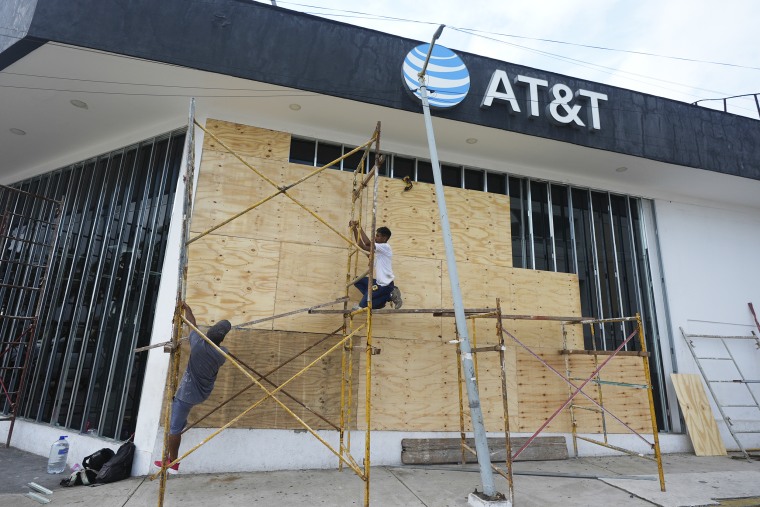PUERTO ESCONDIDO, Mexico — Hurricane Erick made landfall early Thursday on the Pacific coast of Mexico as a major Category 3 storm, the National Hurricane Center said.
Erick made landfall after 6 a.m. CT in extreme western Oaxaca, just east of Punta Maldonado, with estimated maximum sustained winds near 125 mph, the center reported.
It had rapidly intensified from a Category 1 hurricane yesterday to an “extremely dangerous” Category 4 storm with sustained winds of 146 mph.
A major hurricane is defined as Category 3 or higher and wind speeds of at least 111 mph.
The storm is moving northwest at nearly 9 mph, the hurricane center said in its 7 a.m. ET update.
The center of the hurricane is forecast to move inland over southern Mexico throughout the day. Erick is forecast to rapidly weaken over the mountains of Mexico and dissipate Thursday night or early Friday, the hurricane center said.
Erick will produce 8 to 12 inches of rainfall, with maximum totals of 16 inches, across the Oaxaca and Guerrero states, that will lead to “life-threatening flooding and mudslides,” the hurricane center said. Destructive winds will also lash out near Erick’s core and dangerous, life-threatening storm surge is expected to produce coastal flooding.
Videos on social media early Thursday showed staggering flash flooding with streets overwhelmed by rushing floodwaters and people walking in knee-deep water.
A major hurricane making landfall on this part of Mexico in June is very rare. Erick is the earliest major hurricane to make landfall on Mexico’s Pacific coast.
Storm moves south on approach
Late Wednesday, Erick’s projected path crept south, closer to the resort city of Puerto Escondido in Oaxaca state, and centered on a sparsely populated stretch of coastline between the Oaxacan resort and Acapulco to the northwest.
Mexican President Claudia Sheinbaum said in a video message Wednesday night that all activities in the region were suspended and she urged people to stay in their homes or to move to shelters if they live in low-lying areas.
Waves were crashing onto the esplanade in Puerto Escondido by nightfall, swamping wooden fishing boats that had been pulled up there for safety. The beach disappeared under pounding waves and the rising tide had already reached the interiors of some waterfront restaurants.
Last-minute purchases ended at nightfall as stores closed and the streets emptied.
Earlier in the day, fishermen in Puerto Escondido pulled their boats out of the water ahead of the storm’s arrival. Some surfers continued to ride waves at the Zicatela beach, even with red flags up to warn people to stay out of the water.
The storm’s course shift could be welcome relief for residents of storm-battered Acapulco.
The city of nearly 1 million was devastated in October 2023 by Hurricane Otis, a Category 5 hurricane that rapidly intensified and caught many unprepared. At least 52 people died in Otis and the storm severely damaged almost all of the resort’s hotels.
Acapulco still scarred by Otis
Acapulco residents said they were bracing for Erick’s arrival with more preparation and trepidation because of the memory of the devastation wrought by Otis two years earlier.
Guerrero Gov. Evelyn Salgado said via X that all movement in Acapulco and other beach communities was to be suspended at 8 p.m. Schools across the state were to remain closed for a second day Thursday.
Carlos Ozuna Romero, 51, lost his restaurant at the edge of an Acapulco beach when Otis slammed the resort with devastating winds. On Wednesday, he directed workers storing tables and chairs.
“Authorities’ warnings fill us with fear and obviously make us remember everything we’ve already been through,” Ozuna Romero said in reference to Otis.

Elsewhere, workers nailed sheets of plywood over shop windows and stacked sandbags outside doorways. Cars lined up to fill their tanks and shoppers made last-minute purchases before rushing home.
Verónica Gómez struggled through the streets of Acapulco with a large jug of water. “We’re all afraid because we think the same thing could happen,” said the 40-year-old employee of a shipping company.
But she said she and others learned a lot from Otis. “Now it’s not going to catch us by surprise,” she said, holding out a bag of canned food as evidence.
In Acapulco on Wednesday, there was a strong presence of the national guard and police in the streets, but most visible were trucks from the national power company. Crews worked to clear drainage canals and brush.
Rain could be Erick’s legacy
Forecasters said Erick was expected to lash Mexico’s Pacific coast with heavy rain, strong winds and a fierce storm surge. Rain of up to 16 inches could fall across the Mexican states of Oaxaca and Guerrero, with lesser totals in Chiapas, Michoacan, Colima and Jalisco states, the hurricane center’s advisory said. The rainfall threatened flooding and mudslides, especially in areas with steep terrain.
A hurricane warning is in effect for Acapulco to Puerto Angel, a hurricane watch in effect for west of Acapulco to Tecpan de Galeana, and tropical storm warning in effect east of Puerto Angel to Salina Cruz and west of Acapulco to Tecpan de Galeana.
Laura Velázquez, Mexico’s national civil defense coordinator, said Erick was forecast to bring “torrential” rains to Guerrero, Oaxaca and Chiapas in southern Mexico. The mountainous region along the coast is especially prone to mudslides with numerous rivers at risk of flooding.
Salgado said the state had alerted all of the fishing and tourism operators to make their boats storm-ready. Acapulco’s port closed Tuesday evening. Salgado said 582 shelters were set to receive people who might evacuate their homes.
Having doubled in strength in less than a day, Erick was churning through an ideal environment for quick intensification. Last year, there were 34 incidents of rapid intensification — when a storm gains at least 35 mph in 24 hours — which is about twice as many as average and causes problems with forecasting, according to the hurricane center.


